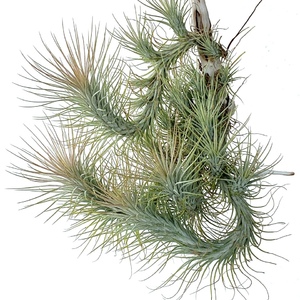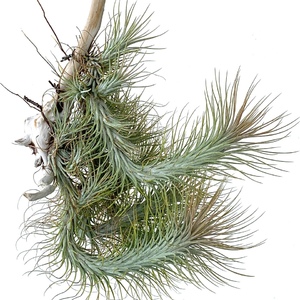植物经验
详细说明
Tillandsia funckiana is an absolute must have in anyone’s collection. It originates from Central America, namely Venezuala, but I could not find any further detailed information on their actual habitat. Funckiana is a smallish plant, with silvery grey pine needle-like leaves growing along a stem. Individual plants look very delicate and graceful, but if you manage to grow this into a clump it looks absolutely spectacular.
Funckianas love the sun and mine get direct morning sun up until 1pm. The other aspect of course is water, and if you have them in such sunny and airy conditions, be sure to keep them suitably hydrated if you want to prevent the ends of the plant from drying out. My place is sufficiently dry and breezy that I have even watered them twice a day, particularly during the mini heatwaves that occasionally occur here. I find that once they have adapted to the growing conditions, they are actually pretty fast growing.
Basic Tillandsia care:
Watering for Tillandsia will vary by location, If kept indoors you can water them by fully submerging the plant in filtered, RO, or bottled water water for up to an hour. Tillandsia have small scales on the surface of their leaves (called trichomes), which allow them to suck up water. These trichomes are very similar to butterflies' wing sclaes, they are fragile and will rub off from excessive handling. When watering you want them to sit in the water so your plants enough time for the scales to become fully saturated. Depending on their last watering this could take a few minutes to hours.
Airflow is another important factor for Tillandsia. Wet plants should be left out in an area that will let them completely dry out by night fall. Stagnant water in the base of the plant will cause crown rot and destroy your plants.
Carbon monoxide is absorbed by Tillandsia only at night, meaning that respiration mostly occurs at night! This makes it important that they have a night cycle.
Bright filtered light should be provided for Tillandsia. A 60%-40% shade cloth can be used for outdoor plants during summer-winter. Vivarium plants can be maintained with a full spectrum bulb. Most houseplants will do well in any area they can have bright filtered light. Most south facing windows will be too intense of a light and burn the plants. Higher light will also increase the amount of watering the plant will need.
90-50F is the best temp range for these plants. Any frost will cause your plants major damage and losses.
Funckianas love the sun and mine get direct morning sun up until 1pm. The other aspect of course is water, and if you have them in such sunny and airy conditions, be sure to keep them suitably hydrated if you want to prevent the ends of the plant from drying out. My place is sufficiently dry and breezy that I have even watered them twice a day, particularly during the mini heatwaves that occasionally occur here. I find that once they have adapted to the growing conditions, they are actually pretty fast growing.
Basic Tillandsia care:
Watering for Tillandsia will vary by location, If kept indoors you can water them by fully submerging the plant in filtered, RO, or bottled water water for up to an hour. Tillandsia have small scales on the surface of their leaves (called trichomes), which allow them to suck up water. These trichomes are very similar to butterflies' wing sclaes, they are fragile and will rub off from excessive handling. When watering you want them to sit in the water so your plants enough time for the scales to become fully saturated. Depending on their last watering this could take a few minutes to hours.
Airflow is another important factor for Tillandsia. Wet plants should be left out in an area that will let them completely dry out by night fall. Stagnant water in the base of the plant will cause crown rot and destroy your plants.
Carbon monoxide is absorbed by Tillandsia only at night, meaning that respiration mostly occurs at night! This makes it important that they have a night cycle.
Bright filtered light should be provided for Tillandsia. A 60%-40% shade cloth can be used for outdoor plants during summer-winter. Vivarium plants can be maintained with a full spectrum bulb. Most houseplants will do well in any area they can have bright filtered light. Most south facing windows will be too intense of a light and burn the plants. Higher light will also increase the amount of watering the plant will need.
90-50F is the best temp range for these plants. Any frost will cause your plants major damage and losses.
花相册 (5)





kensong
2019年08月18日

Exactly one year on amd how it has grown.




kensong
2019年01月06日

Babies have sprouted.


kensong
2018年08月16日


kensong
2018年08月16日

This is my first growing diary. AugustFame RM45 with Wood.







